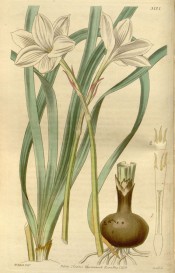Zephyranthes drummondii D.Don
Bulbous perennial usually with about 7 linear, twisted, prostrate leaves to the bulb, and flowering stems, to 20cm long, with fragrant white flowers, tinged red outside, opening at night in summer. To 25cm. [RHSD, Hortus, Baker Am.].
Horticultural & Botanical History
Baker describes Zephyranthes drummondii and Z. pedunculata as separate species, the latter with a longer perianth tube. [Baker Am.].
‘This [Cooperia pedunculata] is another of Drummond’s bulbs, which has flowered at Dr. Neill’s, in the Edinburgh and Glasgow Gardens, and at Spofforth. It was not observed during the night in Scotland, nor seen to expand perfectly. It did not flower at Spofforth till the 20th of September, the weather being then very cold and and cloudy. The scape and spathe were pale reddish, the bud tinged with a faint blush. A little before sunset it expanded a little, the limb having grown pure white; in that posture it remained till the same hour the next evening, when it opened a little wider, and on the third evening it made a fresh effort and reached a state of about half expansion; the next moming the sepals acquired a red tinge on the outside, and the flower began to shrivel. It had the same primrose-like fragrance as Drummondiana [Z. chlorosolen]. The petaline filaments were prolonged a little, adhering to the base of the petals; the style in my specimen was only half the length of the tube. The tube was quite as erect and cylindrical as in Drummondiana, the figure in Sweet’s British Flower Garden being very incorrect in that respect. I was at a loss to understand the capricious non-expansion of these nocturnal flowers, but I am convinced that it arises from the manner in which they have been treated. Increase of temperature prevents their expansion, and probably would obstruct the opening of any night-blowing flower. The requisite for. producing the flower is a certain mean temperature, but a gradual decrease of temperature, such as usually takes place at sunset, is necessary or its expansion.’ [Herbert p.180/1837].
‘The plant is a native of Texas, and was sent from thence in 1835 to this country. It has since flowered in several collections: firstly, at Dr. Neill’s; also at Messrs. Dickson’s, from whose specimens the accompanying figure was made in March, 1836, at the Glasgow Botanic Garden, and at Mr. Herbert’s of Spofforth, who has kindly communicated some further information, in September, 1836. “It is,” he says, “like the other Cooperiae, a decodely nocturnal flower; that is, its expansion takes place about an hour or half an hour before sunset. My flower did not expand perfectly , but its first attempt was just before sunset; and in that posture it remained till the same hour the second day, when it opened, and on the third day still wider, but not fully, and on the next morning it began to shrivel and to grow red on the outside of the sepals, as C. Drummondi does. It has the same primrose-like fragrance as that species. Its petaline filaments are a little prolonged. I have been puzzled about the capricious non-expansion of the Cooperias; but I think I now understand them. Encreased temperature does not aid it, but prevents it, and probably would of any nocturnal flower: the thing necessary for its expansion seems, on the contrary, to be the decrease of the mean temperature. The requisite is, therefore, a given mean temperature, and the decrease which occurs in the evening. In the stove, or greenhouse, unless the sun shines all day, there is not that decrease of the temperature at sunset which causes it to open, and therefore its expansion is sluggish and imperfect: and it so happened that the weather was very cloudy and cold, and when the lights were shut, the house in which this bulb stood was warmer than it had been in the day. The second day was warmer, and the third still more so, though all cloudy, therefore there was a greater difference in the evening, which caused those three efforts of the flower. If I had placed the plant in the open air the day before its expected expansion, I am confident that it would have opened flat. C. Drummondi, set out of doors before expansion, opened flat at night, and continued so three days. In the stove in cold weather it never opened at all, because there was no de- crease of temperature.” [BM t.3727/1840].
Both Zephyranthes drummondii and Cooperia pedunculata were introduced to Britain in 1835. ‘We would have named this genus “The Evening Star”. It is anomalous amongst its race for first opening its starry-white flowers in the cool of the evening. They possess the fragrance of a primrose.’ [JD]. Bulbs or seeds were imported by Loddiges’ Nursery from Mexico and it is probable that the specific name ‘Mexicana’ derived from this importation. See also OFG f.234/1854.
History at Camden Park
Probably introduced to the gardens between 1843 and 1845. Listed in the 1845, 1850 and 1857 catalogues under the name Cooperia pedunculata [B.75/1845]. This plant is still growing in the vicinity of the gardens, recently discovered naturalised in grass in one small area. Click here to see a photograph of this plant.
Notes
Published May 16, 2009 - 05:17 PM | Last updated Aug 12, 2012 - 03:39 PM
| Family | Amaryllidaceae |
|---|---|
| Category |
|
| Region of origin | Texas, Mexico |
| Synonyms |
|
| Common Name | Rain lily, Prairie lily, Evening star, Rain flower, Wind flower |
| Name in the Camden Park Record |
Cooperia pedunculata
|
| Confidence level | high |
